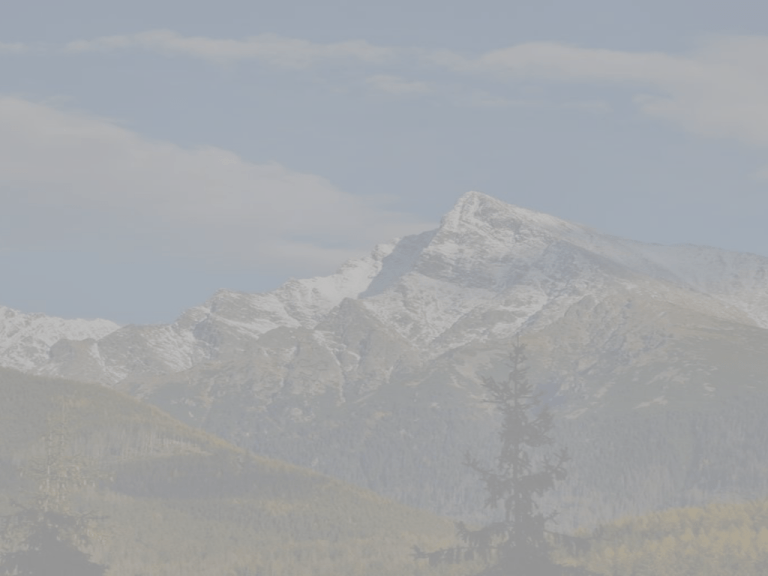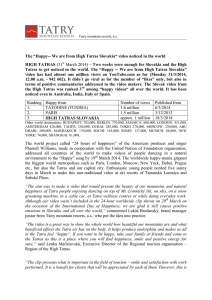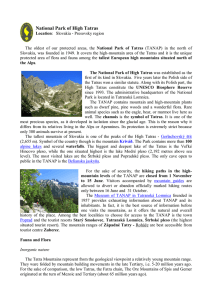Snímka 1
advertisement

CONTENS • 1.Tatras 1.1 Introduction 1.2 Location 1.3 Discerption 1.4 Relief 1.5 Tarns 1.7 Waterfalls 1.8 Climate 1.9 Fauna 1.10 Flora 1.11 Tourism 1.11.1 Sports 1.11.2 The most frequently visited place 1.11.3 Museums 1.1 INTRODUCTION The Tatra Mountains are the highest mountain range in the Carpathian Mountains. Although considerably smaller than the Alps, they are classified as having an alpine landscape. Their high mountain character, combined with great accessibility, makes them popular with tourists and scientists. The highest peak is Gerlach in height 2655 m. 1.2 Location • The High Tatras are situated in the north part of Slovakia. It’s placed on the small area with length 26 kilometers so the High Tatras are the smallest. 1.3 Discerption The Tatras consist of: • The Western Tatras • The Eastern Tatras which consist of: – High Tatras – Belianske Tatras TheWestern Tatras The High Tatras The Belianske Tatras (with name of some peaks) 1.4 Relief • Tatras relief is the work of rivers and mountain glaciers. • There were together 41 mountain glaciers which rolled down the valleys and created a distinctive V-shaped valley, U. In several places the moraine walls consisting of huge boulders, gravel and clay. Javorová valley Liptovská valley Tichá valley Žiarska valley 1.5 Tarns • In Quaternary the early warming was melting of glaciers. In some places are glacial lakes- tarns. In the Tatra Mountains is more than 200 lakes. Largest in the territory of Slovakia is Large Hincovo tarn in Mengus valley. They are also known Nižné and Vyšné Tarn, Štrbské tarn,Popradské tarn, Rocky and Green Tarn. The territory of Tatras belongs to the Drainage area Black Sea and Baltic Sea. Many famous rivers rise in the Tatras. For example, Vah. Štrbské tarn Štrbské tarn Popradské tarn Big Hrincovo tarn (biggest one) 1.7 Waterfalls • The best known are: A huge waterfall in the mouth of Cold Creek and jump waterfall in Mlynska Valley. The Jump Waterfall The Huge Waterfall 1.8 Climate • The climate has more alpine character is so cool and damp affected by the division of individual relief. Snow cover in the Tatras persists. In the valleys measured 180 cm in the higher areas up to 250 cm. In difficult terrain there is therefore a slide avalanches. For Tatras is a typical windy weather 300 days per a year. The average annual temperature for 1000m.n is 5 degrees Celsius in July 15 degrees Celsius. 1.9 Fauna • The Tatra Mountains are home to many species of animals: 54 tardigrades, 22 turbellarians, 100 rotifers, 22 copepods, 162 spiders, 81 molluscs, 43 mammals, 200 birds, 7 amphibians and 2 reptiles. The most notable mammals are the Tatra chamois, marmot, snow vole, brown bear, wolf, Eurasia lynx, red deer, roe deer, and wild boar. Notable fish include the brook trout and alpinebullhead. The endemic arthropod species include a caddis fly, spider and a springtail. Bear Chamoi Snow vole Marmot 1.10 Flora • The Mountains have a diverse variety of plants. They are home to more than 1,000 species of vascular plants, about 450 mosses, 200 liverworts, 700 lichens, 900 fungi, and 70 slime moulds. There are five climaticvegetation belts in the Tatras: • The distribution of plants depends on altitude: • up to 1,300 m: Carpathian beech forest; almost no shrub layer, herb layer occupies most of the forest floor • to 1,550 m: Spruce forest; shrub layer poorly developed, mosses are a major component • to 1,800 m: Mountain Pine, numerous herbs • to 2,300 m: high altitude grasslands • from 2,300 m up: Subnivean - bare rock and almost no vegetation (mostly lichens) 1.11 Tourism • The region of the High Tatras is rich in natural beauties . There are very good conditions for mountain sports both in summer and in winter . Due to their climate position and altitude the mountains have very good conditions for curing respiratory diseases. 1.11.1 Sports • The High Tatras offer wide range of sports. The main touristic centers are in the south of the Tatras. People can choose from many kinds of sports – skiing, alpine skiing, bungee jumping, hang-gliding, but the most famous are climbing and hiking • Skiing- The region offers an ideal conditions for skiing in top ski centers. (Podbanské, Štrbské Pleso, Smokovce, Tatranská Lomnica, Skalnaté pleso, Ždiar.) • Climbing- It´s professional and one of the most fascinating sports in the HT . The most attractive hills are Volia veža, Žabí kôň, Batizovský štít, Velická stena, Široká veža, or Ľadový štít. • Hiking- Most visitors come to the HT to hike. In the High Tatras there is a good network of hiking routes (297.5 km). 1.11.2 The most frequently visited places • Popradské pleso- it´s a starting-point for important hiking tours. There is a symbolic cementery where people can see memorial boards of people who died in the HT • Štrbské pleso- it´s a tourist and medical centre. It is famous for its sports complex and one of the world winter events is held there every year. The area has six ski tows and chairlifts. • Skalnaté pleso- it´s the ski resort with the highest altitude and also the best downhill skiing resort. • Lomnický štít- there is an observatory. People can get there by a cable railroad • Rysy- is a border peak between Slovakia and Poland, it´s the highest peak in Poland • Kriváň- is a symbol of Slovakia and freedom of Slavs. We Slovaks believe that a true Slovak patriot should climb Kriváň at least once in their life. Lomnický Peak Rysy Kriváň 1.11.3 Museums • The museum of Liptovská dedina village was opened when LM dam was constructed. Some characteristic houses of the villages where moved to the museum because the villages were flooded during the construction of the dam. • The museum of TANAP pictures Tatra´s nature and history of human relations to nature.











